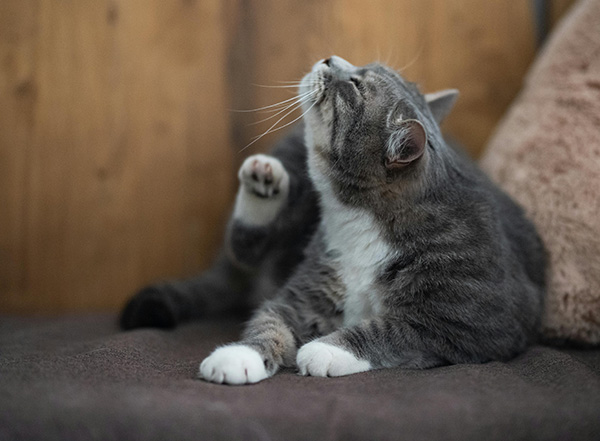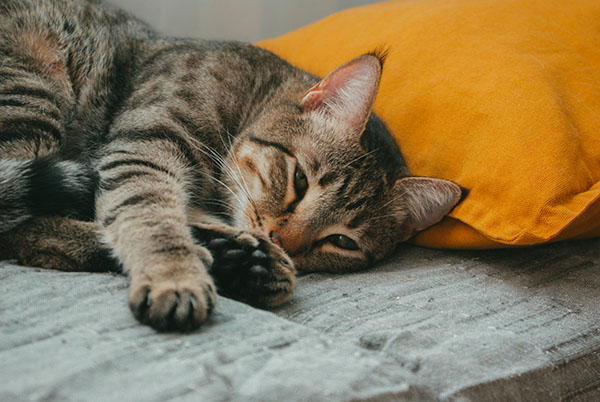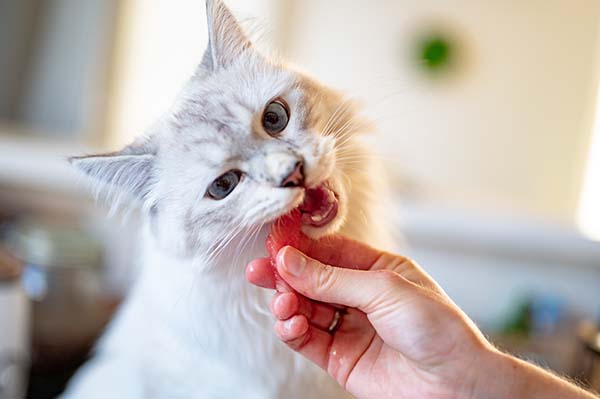Discovering your cat is losing hair can be alarming, but there are home treatments that can help manage and potentially remedy the situation before it escalates. Cat hair loss, or alopecia, can stem from various causes, including stress, allergies, parasites, any underlying cause, or even dietary deficiencies.
In this guide on home treatment for cat hair loss will provide you with effective remedies to address this issue. From identifying causes to using natural treatments, we’ll cover everything you need to help your cat’s fur grow back healthy and strong.
Causes And Treatments for Cat Hair Loss
External Parasites
External parasites commonly cause hair loss in cats, often leading to excessive grooming, scratching, and eventually significant alopecia.
Types of Parasite Infections

Fleas: The most prevalent external parasite in cats. Signs of flea infestation include visible insects on the skin, flea dirt (small black specks), redness, and patches of hair loss. Cats may develop an allergy to flea bites, which exacerbates the skin's reaction and increases hair loss.
Ticks: While less common than fleas, ticks can also cause irritation and hair loss in cats. These parasites attach to the cat’s skin, leading to inflammation and localized hair loss around the bite site.
Mites: Several types of mites can affect cats, including ear mites, demodex mites, and scabies (sarcoptic mites). Mite infestations often lead to severe itching and scaling, resulting in hair loss. Ear mites, for instance, produce intense itching inside the ears and can lead to hair loss around the head and neck from scratching.
Lice: Although uncommon in cats, lice can lead to itching, irritation, and hair loss. They are visible to the naked eye and can be seen moving in the fur or found as nits (lice eggs) attached to the hair shafts.
Signs to Look For
Excessive scratching, biting, or licking
Visible parasites on the skin or in the fur
Red, inflamed skin
Patches of hair loss or thinning fur
Scabs or crusts on the skin
External parasites like fleas are a common culprit behind your cat’s hair loss. Effective treatments include products like Fipronil (Frontline Plus), Imidacloprid (Advantage), and Selamectin (Stronghold/Revolution), which can eliminate these pests.
Natural remedies can also be quite effective. For instance, spraying apple cider vinegar on your cat’s coat can encourage fleas to leave the body. Gentle dish soap can kill fleas by breaking down their exoskeleton when lathered into a wet coat. Lavender, applied as a steeped spray, serves as a natural repellent.
Regular cleaning of carpets, bedding, and sofa covers and frequent vacuuming can eliminate flea eggs and larvae from your home. This helps keep the environment pest-free, aiding in your cat’s recovery and preventing further hair loss.
Food Allergies

Though food allergies are relatively rare in cats, affecting roughly 1% of the population, they can cause significant discomfort and hair loss. Food allergies in cats can often manifest through skin issues, including hair loss, medically referred to as alopecia. These allergies are typically reactions to proteins found in pet food ingredients like chicken, beef, or dairy. When a cat experiences a food allergy, its immune system incorrectly recognizes the protein as a threat, causing an inflammatory response. This response can cause symptoms such as itching, redness, and skin lesions, leading to hair loss due to the cat's persistent scratching and licking of irritated areas.
Switching to a hypoallergenic diet, which often includes novel proteins like lamb, duck, and venison, helps manage food allergies. A strict diet trial for 8 to 12 weeks is needed to diagnose food allergies, with symptoms potentially improving within 10 weeks. Carefully monitoring and adjusting your cat's diet can enhance their skin health and minimize hair loss.
Fungal Infections
Fungal infections are a significant cause of hair loss in cats, often leading to patchy, circular areas of hair loss along with other skin abnormalities. The most frequent fungal infection in cats is ringworm or dermatophytosis. Despite its name, ringworm is a fungus, not a worm, and it targets the skin, hair, and nails. It’s highly contagious and can be transmitted between animals and humans.
Types of Fungal Infections:
Ringworm (Dermatophytosis): The most prevalent fungal infection in cats, characterized by circular, bald patches that may appear red and scaly.
Malassezia Dermatitis: Resulting from an overgrowth of yeast that typically resides on the skin. This can lead to greasy, inflamed skin and hair loss.
Aspergillosis: Less common; this infection is caused by the Aspergillus species of fungus, affecting the nose and sinuses, potentially causing ulceration and hair loss around the nose.
Symptoms include:
Itchy skin
Circular or irregular patches of hair loss
Redness, scaling, or crusting of the skin
Black or white specks on the skin or in the fur
Bad skin odor
Diagnosis typically involves a fungal culture or examination of hairs under a microscope. Treatment for fungal infections may involve topical antifungal creams, medicated shampoos, or oral antifungal medications, depending on the type and severity of the infection.
Since fungal infections can spread within a household, it's important to treat all affected animals and thoroughly clean the environment. Separating infected cats and thoroughly disinfecting the home are effective measures to prevent the spread of ringworm. Long-term treatment, usually lasting at least six weeks, ensures the infection is fully eradicated, allowing your cat’s fur to regrow healthily. Consistent veterinary visits are vital for properly managing and treating cat fungal issues.
Stress and Anxiety

Stress and anxiety can greatly affect a cat's overall health and may lead to physical symptoms such as hair loss. When cats are stressed, their bodies produce hormones that can impact skin health and disrupt hair growth cycles. This hormonal imbalance can lead to excessive grooming behaviors, known as psychogenic alopecia, where cats lick or chew their fur excessively, leading to hair loss primarily on their abdomen, legs, and along the back. This behavior is a symptom and a coping mechanism for stress.
Signs to look for:
Excessive and over-grooming: Cats may lick or chew their fur compulsively.
Bald patches: Particularly on accessible areas like legs, abdomen, and sides.
Changes in behavior: Increased hiding, aggression, or changes in eating and sleeping patterns.
Skin irritation or redness: From excessive licking.
Addressing both the symptoms and underlying causes of stress in cats is crucial. Environmental changes, such as moving to a new home, changes in the family dynamic, or conflicts with other pets, can trigger stress responses. Providing a stable environment, interactive play sessions, and possibly anxiety-reducing products like pheromone diffusers may help. Synthetic pheromones like Feliway can create a calming environment, reducing the cat’s stress. Additionally, providing a quiet, clutter-free space for your cat to rest helps manage stress.
Bacterial Infections
Bacterial infections are a significant cause of hair loss in cats. They often result from or exacerbate underlying skin conditions. These infections harm the skin and hair follicles, resulting in either patchy or extensive hair loss.
Types of Bacterial Infections:
Pyoderma: Typically involves surface, superficial, or deep skin infections. Deep pyoderma can cause severe issues, including hair loss, due to infection penetrating deeper layers of the skin.
Folliculitis: This is an infection of the hair follicles, often secondary to other skin conditions such as scabies or allergies, leading to hair loss.
Impetigo: More common in kittens, this condition is characterized by pustules that can burst and form crusts, often affecting the hairless parts of the body.
Cellulitis: A deeper infection that can occur if wounds or superficial infections are left untreated, potentially leading to more significant hair loss if the infection spreads.
Signs to Look For:
Redness and swelling of the skin
Presence of pustules or crusted areas
Hair loss around infected areas
Itchiness and discomfort, leading to excessive scratching or licking
Foul odor from infected areas
Treatment involves antibiotics to combat the bacterial infection and may include topical treatments or oral medications depending on the severity and depth of the infection. It is also important to address any underlying issues, such as allergies or injuries, to avoid recurrence. Regular veterinary check-ups are essential to ensure the infection is appropriately managed and to monitor the cat’s recovery. Prompt intervention can prevent more serious complications and support the health of your cat's skin and coat.
Nutritional Deficiencies

A balanced, nutritious, healthy diet is key to maintaining your cat’s skin and coat health. Cats need a protein-rich diet, vitamins, and essential fatty acids. Animal-based proteins are particularly crucial as they provide all the essential amino acids necessary for a cat’s well-being.
Linoleic acid, present in chicken fat and certain vegetable oils, is vital for maintaining skin and coat condition. An omega-6 to omega-3 fatty acid ratio between 5:1 and 10:1 helps prevent skin conditions and promotes a healthy, shiny coat.
Vitamins A and E are also essential. Vitamin A aids skin growth and repair, whereas Vitamin E is an antioxidant that protects skin cells. A well-rounded diet can significantly improve your cat’s coat quality, resulting in a shiny, healthy appearance.
Hormonal Imbalances
Hormonal imbalances in cats can lead to various health issues, including hair loss, often due to changes in the skin and hair growth cycles. These imbalances are typically related to the dysfunction of glands such as the thyroid, adrenal, or pituitary glands, each affecting hair growth differently.
Common Hormonal Imbalances That Cause Hair Loss:
Hyperthyroidism: This condition is caused by an overproduction of thyroid hormones and can lead to fur thinning, particularly evident on the flanks and sides of the body.
Hypothyroidism: Though rare in cats, it results from insufficient thyroid hormone production, leading to hair loss and a dull, brittle coat.
Cushing’s Disease (Hyperadrenocorticism): Caused by excessive cortisol, either due to adrenal gland tumors or long-term use of corticosteroids, leading to thin skin and hair loss.
Signs to Look For:
Symmetrical hair loss, often starting on the belly, sides, or flanks.
Thinning of the coat without obvious itching.
Changes in skin texture, becoming thin or excessively oily.
Increased drinking, urination, or changes in appetite.
Detecting hormonal imbalances often requires blood tests and possibly other diagnostic procedures by a veterinarian. Treatment varies depending on the specific hormonal issue but may involve medication to correct the hormonal levels or manage symptoms. Detecting and addressing these imbalances early can help prevent their progression and enhance the quality of life for affected cats.
